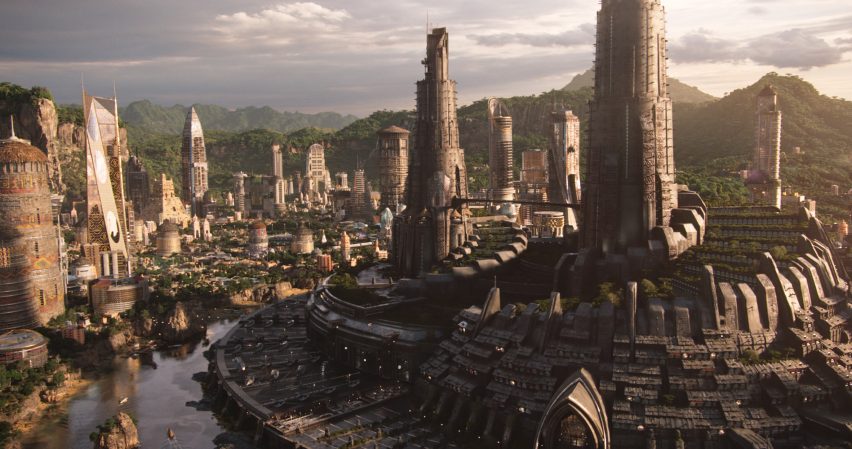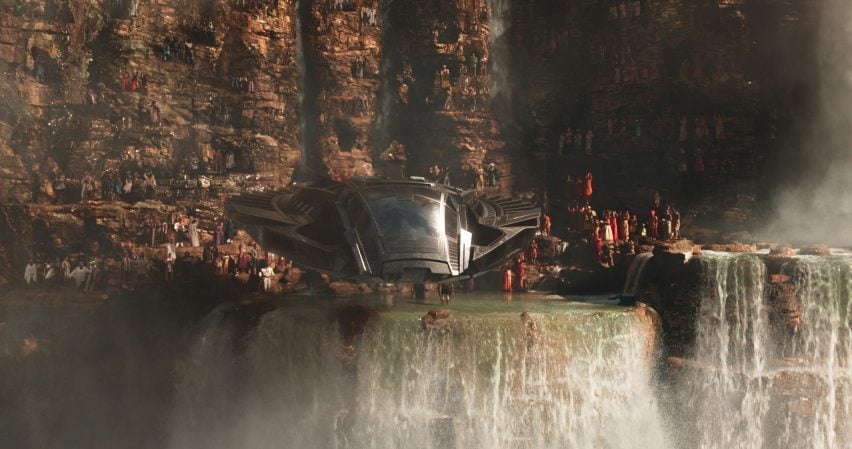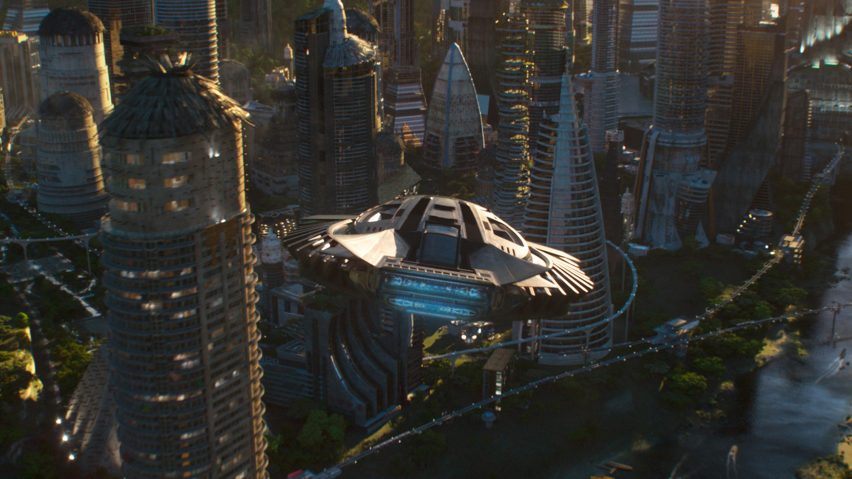The afrofuturist architecture featured in hit movie Black Panther is an unexpected blend of Zaha Hadid and Buckingham Palace, according to designer Hannah Beachler.

Beachler, who worked as production designer on the $200 million movie, told Dezeen that she visited buildings by the late Iraqi-British architect while researching for the film.
"That's what I wanted people to feel for the modern architecture in Black Panther," she said. "Very voluptuous, very curvy, no hard edges and the spaces feel both very large and intimate at the same time."
Movie set in fictional African country
The movie is set in Wakanda, a fictional African country that escaped colonisation and instead developed a vibrant afrofuturist aesthetic and super-powered inhabitants, who are fuelled by a miracle element called vibranium.
Production designer Beachler turned to the architecture of Zaha Hadid, Buckingham Palace and afrofuturism when creating the fictional world for the new Marvel film, which is showing in UK cinemas now.

The film, directed by Ryan Coogler, follows Wakanda’s king T'Challa – the Black Panther, played by Chadwick Boseman – as he attempts to protect his nation from arch-enemy Killmonger, played by Michael B Jordan.
Beachler, a freelance production designer based in New Orleans, came up with the design concept for Wakanda's buildings and cities. Her work is credited as a key reason for the success of the film, which is based on a Marvel comic strip about a black superhero.
Speaking to Dezeen, the designer explained the influences she drew upon when creating the sets and outdoor scenes, which were shot in countries including Uganda, South Africa, Zambia and South Korea.
The inspiration for Black Panther's palace came from Buckingham Palace, home to the Queen of England and the former seat of Britain's colonial power.
However the reason for this choice was largely pragmatic, Beachler said, since the London mansion was mainly used to determine the size of the king's residence.
Black Panther's home based on royal residence
"The first thought I had was, what does Black Panther's palace look like and how big is it?" she explained. "Because that's going to determine how big the rest of the city is."
"The thing that I looked at for size and got all the measurements on was Buckingham Palace, because that was a good size to replicate as far as a palace goes," she explained. "The perfect size for what a palace should be is roughly is 359 feet by 486 feet, like Buckingham Palace."
When it came to designing the rest of the city, Beachler found herself looking to the sinuous buildings of late British-Iraqi architect Zaha Hadid; in particular, the DDP Building in Seoul, completed in 2013, and the Wangjing SOHO in Beijing, completed in 2015.
Beachler visited Zaha buildings for inspiration
Both these structures combine curved, futuristic structures with references to natural elements. The DDP Building has undulating aluminium surfaces that resemble flowing water, while Wangjing SOHO features a curved, tapered structure, designed to look like "three interweaving mountains".
"Walking through Zaha's buildings, it is the curvature of the walls, it is the materials that you connect with. Her walls, for instance, aren't drywall, they're plastered or metal or wooden," Beachler said. "You always feel intimate in a large space because you understand the texture. You connect with it more than if it were just a glass wall."
To achieve this, Beachler created fluid and curved structures for Wakanda, using earth tones and natural materials.
Zaha-style curves were then combined with southern African architectural references, such as the traditional rondavel huts that feature conical, thatched roofs. These can be seen in the design of the skyscrapers in Wakanda's Golden City capital.
Circles everywhere
The repeated use of circles was also intended to create a particular mood in the film, Beachler explained.
"Every single space is a circle that helps calm and relax," she said. "It also represents this continual journey that we're on – this life cycle of birth, life and death that has many representations on the continent. I thought it was very important to put that in the film."
The pairing of these elements helped Beachler create an afrofuturist aesthetic – a style also seen across the film’s costume design and cinematography.
Movie triggers afrofuturism revival
The film has triggered renewed interest in afrofuturism: a cultural movement that combines African and African diaspora culture with technology and science fiction elements.
"You can look to afrofuturism for the aesthetic [of Black Panther]," Bleacher said. "It was really about blending things that were existing in a lot of different African cultures and then creating them as if they had evolved over time and inserting that into our fictional nation."
Afrofuturism also influenced the costumes in the movie, which were designed by African-American costume designer Ruth E Carter. They include 3D printed garments based on clothing and accessories from a range of African cultures, including Turkana and Maasai.
The Black Panther film is the third film Beachler has worked on with director Ryan Coogler. Previous films include 2013's Fruitvale Station and 2015's Creed. Other projects by Beachler include the 2016 Oscar-winning film Moonlight and the video for Beyonce's Lemonade album.

